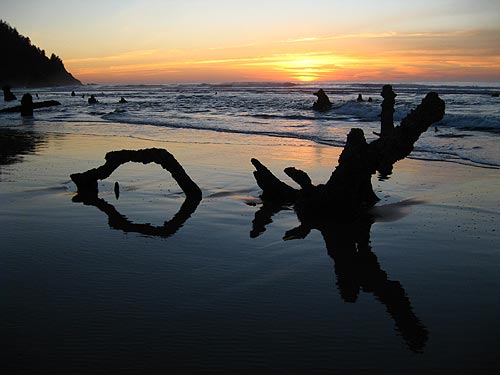 |
Oregon Coast Landmarks: Exploring the Neskowin Ghost Forest
Published 07/26/2011

(Neskowin, Oregon) - It's among the oddest of the attractions along the Oregon coast, and certainly the oldest of the objects you'll find buried in the sand. Although, interestingly enough, it's much more wowing if you know what it is you're looking at.
At first, it looks simply like a grouping of old pilings from a manmade pier sitting in the sand. It’s hard to tell they’re actually tree stumps. They are what is called the “ghost forest” here: a stand of trees some 1,000 to 2,000 years old.
There are about 100 of them poking out of the surf.
 At the Oregon Department of Gem and Mineral Industries (DOGAMI), geomorphologist Jonathan Allan and geologist Roger Hart worked on researching these since the 90’s. Hart passed away in 2011.
At the Oregon Department of Gem and Mineral Industries (DOGAMI), geomorphologist Jonathan Allan and geologist Roger Hart worked on researching these since the 90’s. Hart passed away in 2011.
Back in 2008, the pair told Oregon Coast Beach Connection this striking sight is the result of this patch of trees getting swallowed up by sand and mud, and then hidden far beneath for millennia, which kept them from the decaying effects of oxygen and bacteria. They were in essence preserved by the very sands that killed them.
But exactly how those sands got there is a bit up in the air. Hart and Allan’s research indicates it was a gradual process, but quick in geologic terms – like within a span of a few decades. The sand or some sort of swamp situation simply enveloped the trees because of a change in landscape, thereby killing them but preserving them.
Researchers at OSU in Corvallis have said in recent years they believe it was a bit more cataclysmic, where a massive earthquake – like the one we’re expecting to hit the coast – dropped this chunk of land abruptly, maybe as much as thirty feet. This encased the trees, which were then “decapitated” by a tsunami. Not a pretty thought.

In the late 2000’s, winter erosion started to put the ghost forest at risk. DOGAMI researchers and other state officials began to notice that normal winter erosion processes seemed to be taking more out of some beaches than previous years, and that sand levels were not always being replenished back to normal levels in the spring and summer.
One theory is climate change, which is theoretically resulting in higher ocean levels, which in turn scours more sand out during winters and then does not bring as much back.
“In my opinion, this past winter’s erosion of the buried forests has been more severe than ever before,” Hart told Oregon Coast Beach Connection in 2008. ”Waves have torn up Sitka spruce trees that were rooted in place for one to two thousand years at Neskowin, south of Proposal Rock, and at Cape Lookout State Park, along with great chunks of forest soil. They’ve strewn them all over beaches between Cascade Head and Cape Meares.”
 The irony is the ghost forest may be in jeopardy by the very processes which have let people see them. They had typically been completely covered up over the decades, only visible periodically since the European settlers came here about 100 years ago.
The irony is the ghost forest may be in jeopardy by the very processes which have let people see them. They had typically been completely covered up over the decades, only visible periodically since the European settlers came here about 100 years ago.
Now, because of what appears to be more erosion than usual in this area, they are seen year round. These spectacular and slightly eerie attractions may eventually get torn away in the future, however.
You have to cross a rather strong creek to get to them – and doing this is not for small children.
There are other ghost forests sometimes visible during low sand level events in some winters, like Hug Point near Cannon Beach, Seal Rock, Newport and at Arch Cape. The Neskowin ones are the most interesting, however, and they’re now showing year-round.

More About Neskowin, Pacific City, Oceanside, Netarts, Tierra Del Mar Lodging.....
More About Oregon Coast Restaurants, Dining.....
 |
 |
 |
LATEST OREGON COAST NEWS STORIES
Oregon Coast Whales - Guide to Whale Watching; Whale News, Blog |
Secrets of the Season |
Unusual Travel Articles TravelParanormal.com allows you to submit your own creepy tale or debunk one - or see up-to-the-minute news headlines about travel and the paranormal. News Headlines from All Over Oregon Need to scan Oregon headlines? Constantly updated news from all over Oregon: a comprehensive, up-to-the-minute display of news headlines from a variety of media |
Back to Oregon Coast





































